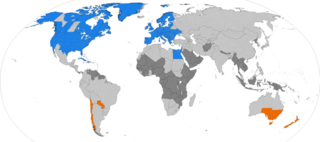
A time zone is an area which observes a uniform standard time for legal, commercial and social purposes. Time zones tend to follow the boundaries between countries and their subdivisions instead of strictly following longitude, because it is convenient for areas in frequent communication to keep the same time.

Japan Standard Time, or Japan Central Standard Time, is the standard time zone in Japan, 9 hours ahead of UTC (UTC+09:00). Japan does not observe daylight saving time, though its introduction has been debated on several occasions. During World War II, the time zone was often referred to as Tokyo Standard Time.

Swatch Internet Time is a decimal time concept introduced in 1998 by the Swatch corporation as part of their marketing campaign for their line of "Beat" watches.

The North American Central Time Zone (CT) is a time zone in parts of Canada, the United States, Mexico, Central America, some Caribbean islands, and part of the Eastern Pacific Ocean.

The Eastern Time Zone (ET) is a time zone encompassing part or all of 23 states in the eastern part of the United States, parts of eastern Canada, and the state of Quintana Roo in Mexico.

The Pacific Time Zone (PT) is a time zone encompassing parts of western Canada, the western United States, and western Mexico. Places in this zone observe standard time by subtracting eight hours from Coordinated Universal Time (UTC−08:00). During daylight saving time, a time offset of UTC−07:00 is used.

The Alaska Time Zone observes standard time by subtracting nine hours from Coordinated Universal Time (UTC−09:00). During daylight saving time its time offset is eight hours (UTC−08:00). The clock time in this zone is based on mean solar time at the 135th meridian west of the Greenwich Observatory.

Summer time in Europe is the variation of standard clock time that is applied in most European countries in the period between spring and autumn, during which clocks are advanced by one hour from the time observed in the rest of the year, with a view to making the most efficient use of seasonal daylight. It corresponds to the notion and practice of daylight saving time (DST) to be found in some other parts of the world.

Eastern European Time (EET) is one of the names of UTC+02:00 time zone, 2 hours ahead of Coordinated Universal Time. The zone uses daylight saving time, so that it uses UTC+03:00 during the summer.

Moscow Time is the time zone for the city of Moscow, Russia, and most of western Russia, including Saint Petersburg. It is the second-westernmost of the eleven time zones of Russia. It has been set to UTC+03:00 without DST since 26 October 2014; before that date it had been set to UTC+04:00 year-round on 27 March 2011.

UTC+03:00 is an identifier for a time offset from UTC of +03:00. In areas using this time offset, the time is three hours later than the Coordinated Universal Time (UTC). Following the ISO 8601 standard, a time with this offset would be written as, for example, 2019-02-08T23:36:06+03:00.

Australia uses three main time zones: Australian Eastern Standard Time, Australian Central Standard Time and Australian Western Standard Time.

There are eleven time zones in Russia, which currently observe times ranging from UTC+02:00 to UTC+12:00. Daylight saving time (DST) has not been used in Russia since 26 October 2014. From 27 March 2011 to 26 October 2014, permanent DST was used.

Time in Brazil is calculated using standard time, and the country is divided into four standard time zones: UTC−02:00, UTC−03:00, UTC−04:00 and UTC−05:00.

Egypt Standard Time (EGY) is UTC+02:00, which is equivalent to Eastern European Time, Central Africa Time, South African Standard Time and Central European Summer Time, and is co-linear with neighbouring Libya and Sudan. Egypt has used Eastern European Summer Time (UTC+03:00), during the summer periods from 1957 to 2010, 2014, 2015, and 2023.

Iran Standard Time (IRST) or Iran Time (IT) is the time zone used in Iran. Iran uses a UTC offset UTC+03:30. IRST is defined by the 52.5 degrees east meridian, the same meridian which defines the Iranian calendar and is the official meridian of Iran.

Most of the United States observes daylight saving time, the practice of setting the clock forward by one hour when there is longer daylight during the day, so that evenings have more daylight and mornings have less. Exceptions include Arizona, Hawaii, and the overseas territories of American Samoa, Guam, the Northern Mariana Islands, Puerto Rico, and the United States Virgin Islands. The Uniform Time Act of 1966 established the system of uniform daylight saving time throughout the US.

As of 2022, daylight saving time is used in the following Asian countries:
The Hanke–Henry Permanent Calendar (HHPC) is a proposal for calendar reform. It is one of many examples of leap week calendars, calendars that maintain synchronization with the solar year by intercalating entire weeks rather than single days. It is a modification of a previous proposal, Common-Civil-Calendar-and-Time (CCC&T). With the Hanke–Henry Permanent Calendar, every calendar date always falls on the same day of the week. A major feature of the calendar system is the abolition of time zones.

Daylight saving time (DST), also known as summer time, is the practice of advancing clocks during part of the year, typically by one hour around spring and summer, so that daylight ends at a later time of the day. As of 2023, DST is observed in most of Europe, most of North America and parts of Africa and Asia around the Northern Hemisphere summer, and in parts of South America and Oceania around the Southern Hemisphere summer. It was also formerly observed in other areas.

















